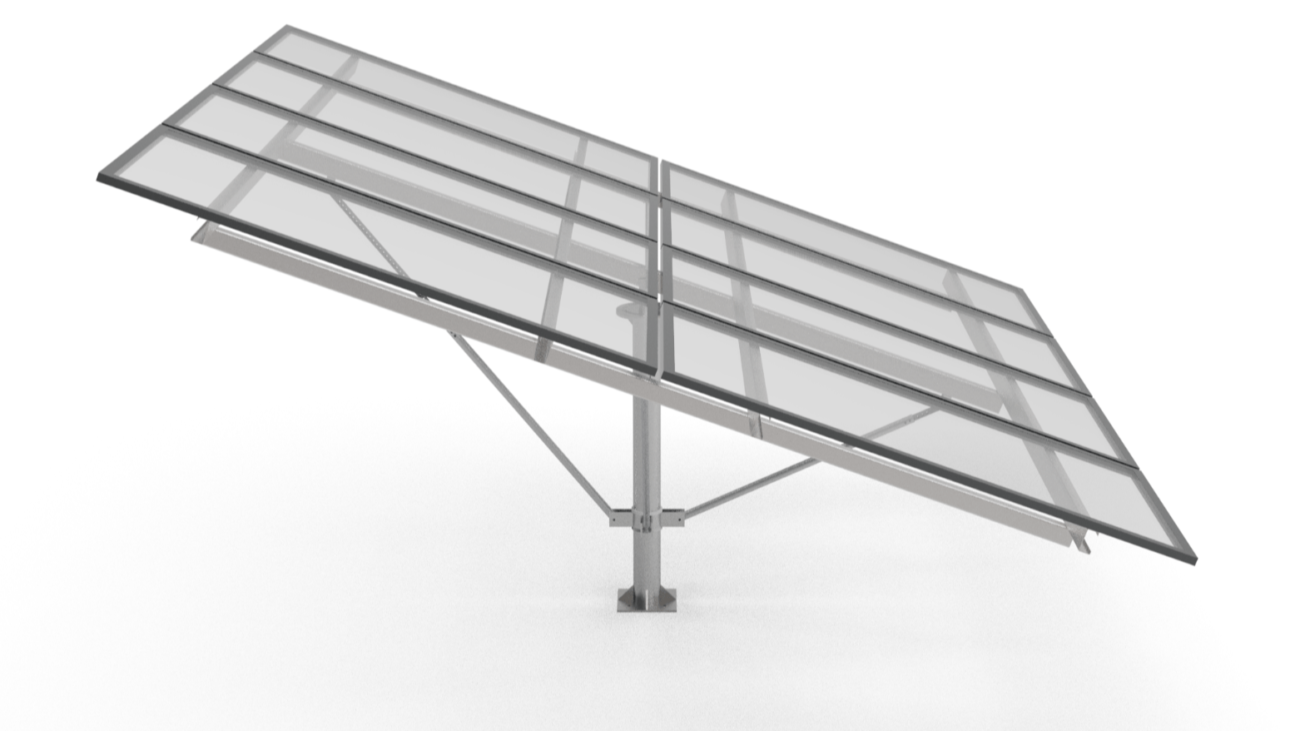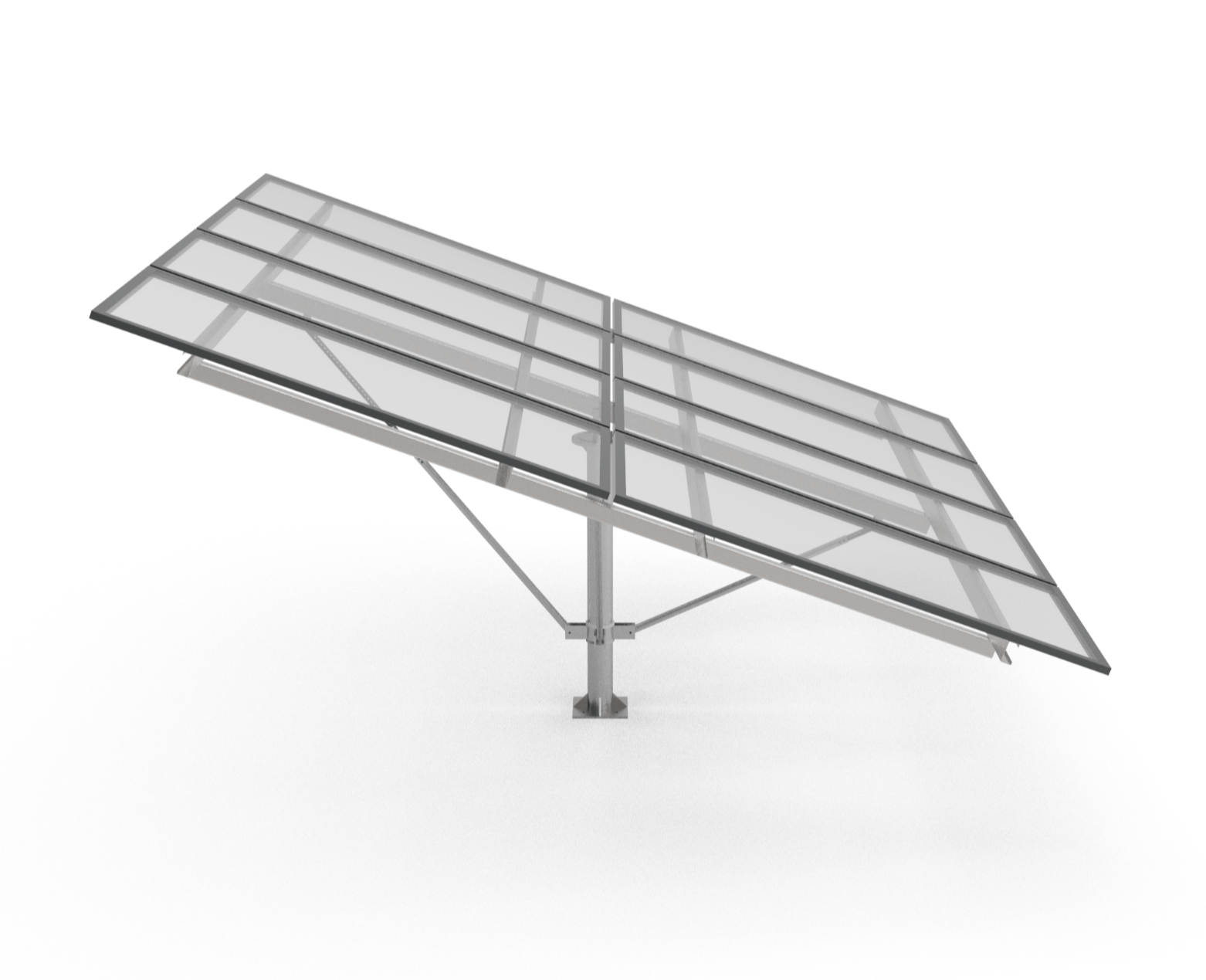
I .Types of Pole Mount Systems
There are several main types of pole mounts used in solar installations, including top of pole mounts, side of pole mounts, and adjustable tilt pole mounts. The type of pole mount system chosen depends on factors like the number of solar panels, wind and snow loads, and site terrain.
Top of Pole Mounts
Top of pole mounts are installed on top of a vertical pole and angle the solar panels upwards towards the sun. They can accommodate anywhere from 1-60 solar panels or more, depending on the specific mounting system.
Some key benefits of top of pole mounts include:
- Increased solar exposure
- Ability to rotate panels to maximize energy production
- Waist-level installation for ease of construction
- Can be used in commercial and residential settings
Side of Pole Mounts
Side of pole mounts attach solar panels to the side of a vertical pole. They generally hold 1-3 solar panels.
Side of pole systems are commonly used for smaller solar installations like:
- Traffic signals
- Security cameras
- Solar lighting
- Off-grid cabins
They can withstand wind speeds up to 90 mph. Like top of pole mounts, side of pole mounts use 2-4.5″ Schedule 40 vertical pipes.
Adjustable Tilt Mounts
Adjustable tilt pole mounts allows for seasonal tilt adjustments to optimize solar exposure. For example, the MT Solar adjustable mount uses a hand crank to tilt panels from 0-90 degrees.
Adjustable tilt mounts are more expensive than fixed mounts but can maximize energy production. They provide an alternative to full solar tracking systems.
The type of pole mount selected depends on factors like location, number of panels, and budget. Consult with an installer to determine the best system for your solar project.
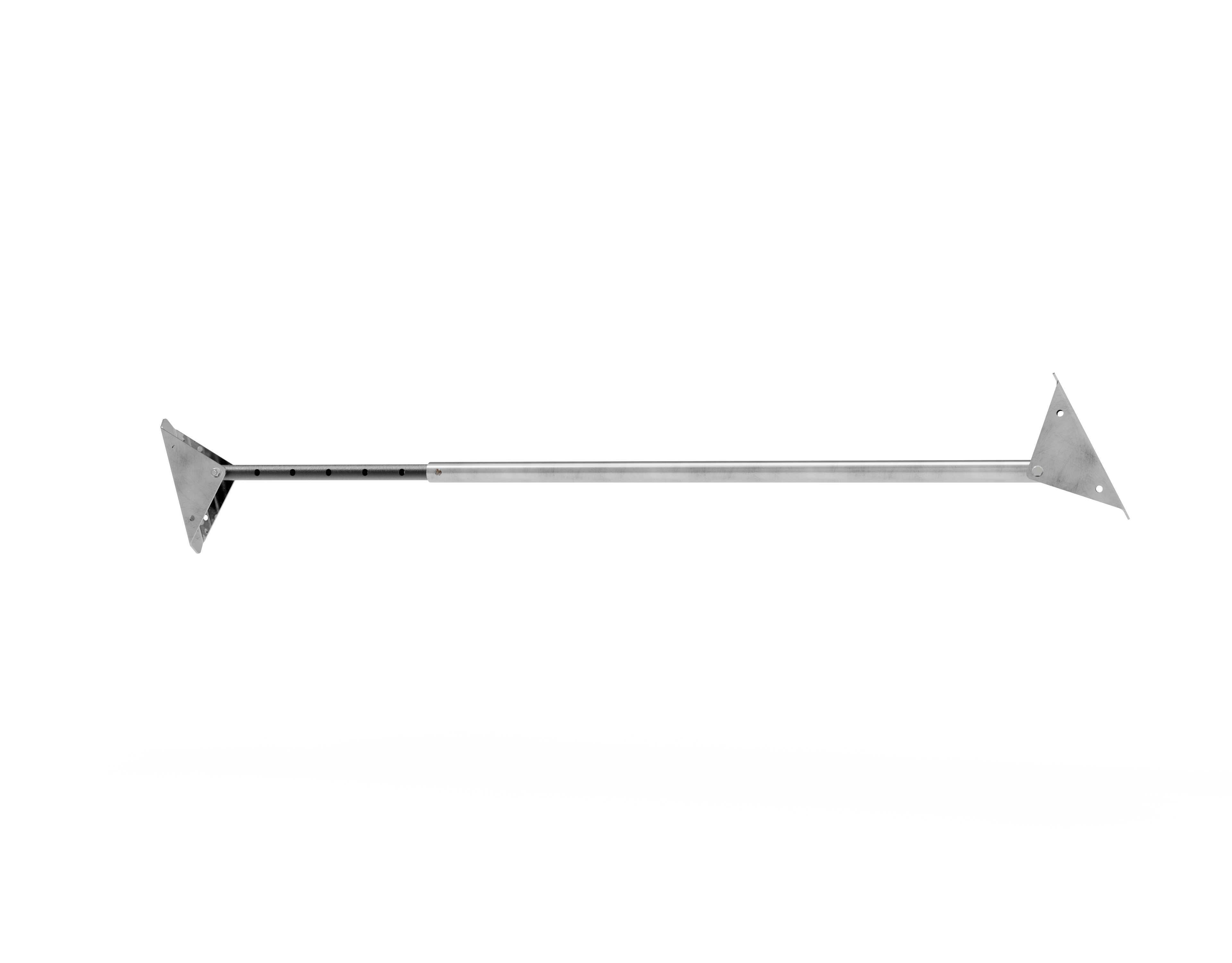
II. Residential Ground Mount Systems
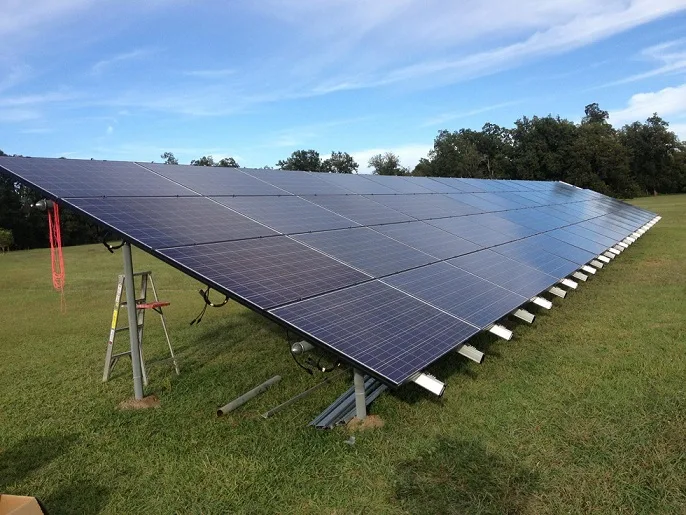
Residential ground mount systems are solar panel installations mounted on frames fixed into the ground rather than the roof. They allow homeowners to install solar when roof space is limited. There are two main types of residential ground mounts:
Low-Profile Ground Mounts
Low-profile ground mounts sit close to the ground and are the most affordable ground-based option. Key features include:
- Shallow concrete footings (30″)
- Quick and easy installation
- Standard SCH 40 pipe materials
- Spans up to 8fts.
| System | Key Features |
| Prosolar GroundTrac System | Integrated grounding, low parts count |
| IronRidges | Meets residential wind and snow load requirements |
Low-profile ground mounts only require basic DIY skills for installation. They provide a cost-effective way to reap the benefits of solar with limited roof space.
Multiple Pole Mounts
Multiple pole mounts elevate solar panels higher off the ground with multiple vertical poles. This allows space for:
- Livestock or crops to graze underneath
- Adjustability – manually tilt pole height each season
- Greater wind/snow clearance
MT Solar offers adjustable multiple pole mounts able to tilt 85 degrees. Systems are easier to install at waist height before lifting into final position.
Benefits of multiple pole mounts include:
- Deeper solar panel clearance
- Manual seasonal adjustability
- Solar exposure maximization
Multiple pole mount systems have a higher upfront cost but provide flexibility and customization options. They are ideal for rural properties or farms.
When deciding on a residential ground mount system, homeowners must consider their property size, local zoning laws, and installation costs. Consulting a solar provider is recommended to determine the best solution.
III .Ramming Pole Mounting Systems
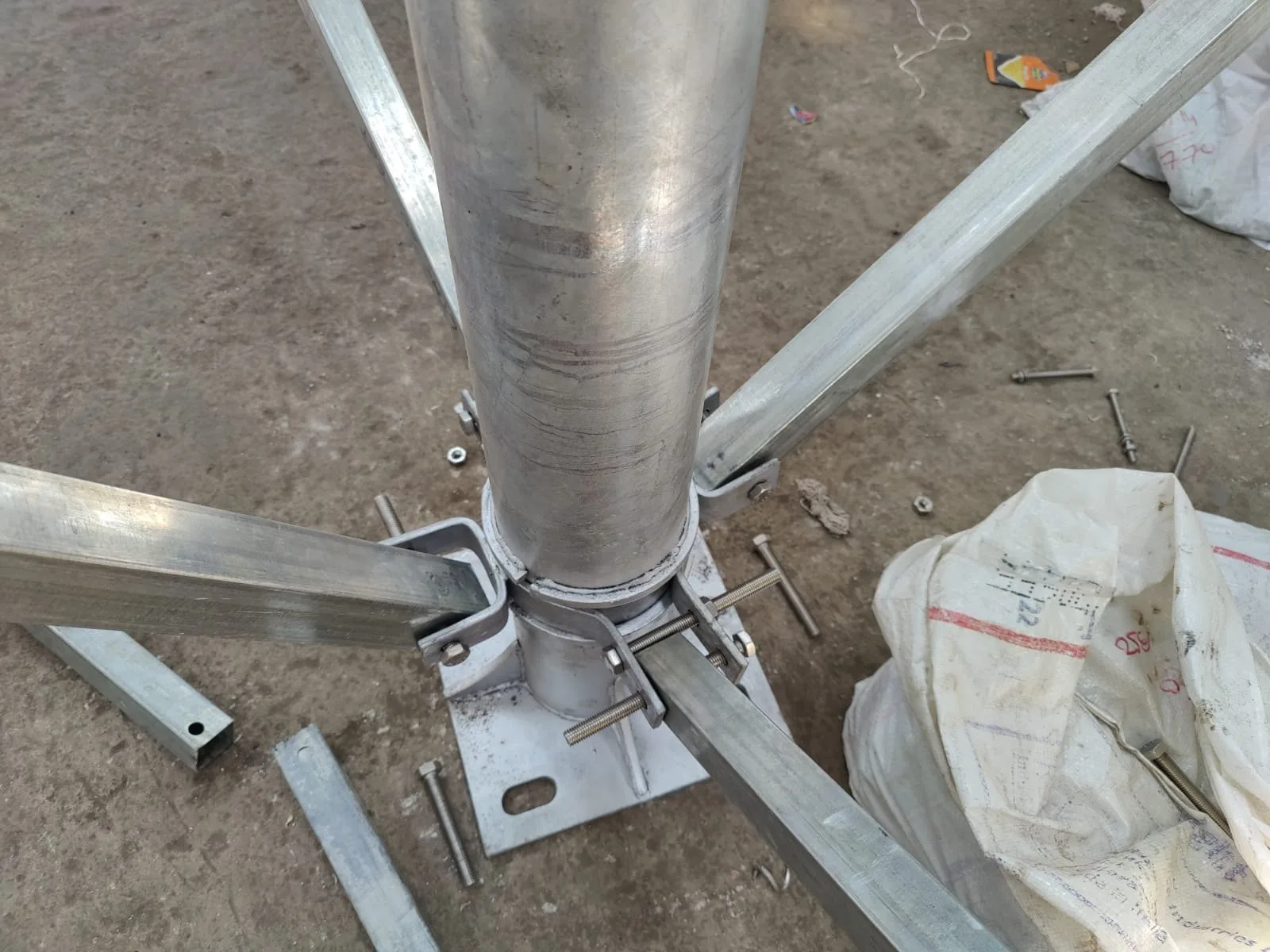
Ramming pole mounting systems are a type of solar panel mount designed for areas with low rock content. Vertical poles are driven into the ground using a pile driver, avoiding complex concrete foundations.
There are two types of ramming pole mounts:
Single Pillar Mounts
Single pillar systems have poles driven 1.5-2 meters into the ground, with a single vertical mount pole.
Key features:
- Easy insertion into soils.
- Adaptable to varying geological conditions.
- Environmentally friendly installation.
- Cost-effective for sites with favourable soil conditions.
| Spec | Details |
| Tilt | Per client needs |
| Wind Rating | 100km/hr |
| Snow Rating | 0.5kN/m^2 |
Double Pillar Mounts
Double pillar mounts add rear pole support for stability. Systems interlock with flanged or non-flanged ramming poles.
Benefits include:
- Extra structural reinforcement.
- Ability to mount more/larger panels.
- Options for steel or aluminium brackets.
Ramming pole systems deliver an affordable, low-impact mounting solution ideal for rural or agricultural sites. Soil conditions should be assessed before installing.
IV. Benefits of Pole Mounting
Pole mounting offers several key advantages over roof mounts and ground mount solar systems. Main benefits of pole mounting include:
Increased Sunlight Exposure
- Mounts elevate panels higher, with no shading obstructions.
- Allows inclusion of sun trackers to follow sunlight.
- Panels can be manually adjusted for seasonal differences.
- Improves airflow and panel efficiency.
Ease of Installation
- Poles quickly driven or embedded into ground.
- Wiring and infrastructure kept underground.
- No need to penetrate building roof membranes.
- Adjustable mounts convenient for maintenance.
More Installation Freedom
- Suitable for oddly shaped lots limiting ground mounts.
- Alternate option if roof cannot bear panel weight.
- Rural sites have space for large pole mount arrays.
- Creative positioning options unavailable on rooftops.
Cost Comparisons
While requiring more hardware, pole mounts yield higher efficiency gains long-term. Lifetime savings offset increased initial investment.
Potential downsides primarily include aesthetic concerns and land usage regulations that restrict pole mount visibility or placement.
With proper site planning and selection, pole mounting solves issues posed by insufficient roof space or shadows. It unleashes the potential for bigger, better solar with sites allowing array visibility.
V. Potential Drawbacks of Pole Mounts
While pole mounts provide increased solar potential, there are some potential drawbacks to be consider:
Aesthetic Concerns
- Large, elevated panel arrays viewed as eyesores.
- Community or municipality restrictions limiting pole visibility.
- Not feasible in dense urban locations lacking open space.
Increased Land Use
- Pole mounts require dedicated open ground space.
- Competes with farmland or livestock grazing areas.
- Not practical for smaller residential properties.
Upfront Costs
- More pole and wiring materials required.
- Labour and equipment rentals add expenses.
- Overall system price estimated 10-20% higher.
Structural Considerations
- Heavy wind/snow loading requirements.
- Hurricane/seismic standards may increase costs.
- Loose soil conditions cannot accommodate poles.
Pole mounting makes the most sense when improved solar exposure outweighs drawbacks like appearance, land usage, zoning issues or costs.
Proper site analysis, pole sizing, and community engagement help mitigate negatives. Engineers tailor mount strength and embedment depth to satisfy structural needs.
Pole mounts excel in rural, agricultural and large commercial settings where improved production returns the added investment. Their application selects sites allowing increased visibility.
VI. Applications for Pole Mounts
Pole mounts work well for certain solar applications with space for visibility. Common examples include:
Rural Properties
- Farms with unused acreage for pole arrays.
- Allows grazing under panels protecting soils.
- Suitable for barns, agricultural buildings.
- Provides backup energy resilience off-grid.
Universities
- Campus roll-out of zero emissions goals.
- High energy research/classroom uses.
- Visibility attracts sustainability-minded students.
- Lower long-term expenses.
Healthcare Centres
- Hospitals are use 2.5x more energy than offices.
- Rooftop HVACs limit available placement space.
- Parking shade structures ideal for pole mounts.
- Enhances community health focus.
Commercial Businesses
- Distribution/logistics centres with large roofs.
- Mount over open storage or vehicle lots.
- Shopping plazas integrating shade and energy.
Pole mounted solar supports infrastructure demands with tailored visibility levels. Farms can isolate arrays daily operations. Campuses highlight sustainability commitments for constituents. Pole mounts ultimately target sites synergizing improved sunlight access with energy resilience and community benefit.
VII. Installation Considerations
Properly installing pole mount solar systems requires assessing:
Structural Requirements
- Wind, snow, seismic ratings to withstand elements.
- Engineer pole sizing, depth, and reinforcement.
- Attachment methods resisting uplift forces.
Site Conditions
- Sun orientation and exposure to maximize production.
- Survey shading from buildings/trees.
- Geotechnical study if loose soil or steep slopes.
Equipment Needs
- Cranes, drills, pile drivers to position poles.
- Conduit for underground wiring runs.
- Adjustable mounts may require generators.
Permitting and Zoning
- Local ordinance setbacks from property lines.
- Visibility restrictions in neighbourhoods.
- ADA access and fire code considerations.
Optional Enhancements
- Integrate pole mounts with trackers.
- Allow space for future solar expansion.
- Plan arrays not to disturb livestock or farming.
Thorough planning and engineering on the frontend streamlines physical pole mount installation. Sites support easier construction and access for maintenance. Drawings should detail buried electrical lines and infrastructure. Establishing relationships with city officials and neighbours smooth approval processes before starting work.
VIII. System Sizing and Design
Properly sizing a pole mount system involves:
Energy Load Calculations
- Estimate site’s annual electricity consumption.
- Add planned consumption increases.
- Account for future electrification goals.
Equipment Selection
- Choose panel wattages and quantities.
- Determine inverter sizes.
- Optimize system design for efficiency.
Structural Specifications
- Local wind, snow, seismic conditions.
- Soil tests detailing composition.
- Panel and hardware corrosion resistance.
Positioning and Layout
- Maximizes unshaded solar exposure.
- Allow access for maintenance and cleaning.
- Optimize spacing and tilt angles.
Pole mount layouts balance generation capacity, equipment capabilities, and site limitations.
| Factor | Design Impact |
| Site area | Number of possible pole mounts |
| Soil quality | Pole foundation sizing |
| Wind loads | Structural reinforcement needs |
Refinements like sun trackers require factoring additional power, controls, and loads.
Proper pole mount design considers present and future energy needs, infrastructure restrictions, and mounting goals. This holistic approach delivers the ideal customized solar installation.
IX. Integration Options
Pole mounts allow integrating supplementary technologies like:
Trackers
- Actively move panels to follow sunlight.
- Increase energy production up to 30%.
- Require rigids poles sustaining tracker/panel movement.
- Typically powered by separate solar PV system.
Hybrid Rooftop Solar
- Pole mounts expand capacity beyond rooftops.
- Combines sites’ generation for resilience.
- Enable incremental solar adoption over time.
- Independent pole operation if roof equipment fails
Storage Batteries
- Store excess solar energy for night time use.
- Important for off-grid or backup power needs.
- Adds consideration for battery cabinet dimensions.
- Increased system costs, but enhances self-supply.
EV Charging Stations
- Solar power emissions-free transportation.
- Mount charging stalls under pole arrays.
- Highlights sustainability commitment.
- Reduces grid impact from EV adoption demands.
Pole mounted solar affordably meets growth through phased buildouts. The independent infrastructure allows customizing improvements over time, avoiding full roof replacements. Strategic options like trackers, storage and EV charging reduces environmental impacts even further.
X. Comparison to Ground Mounts
Pole mounting differs from ground mounts in four key ways:
- Pole mounts elevate panels higher off the ground for improved solar exposure.
- Less land area required for poles versus extensive ground mounting racks.
- Pole mounts sustain higher wind loads with smaller foundation footprints.
- Adjustability possible by tilting pole mounts to optimize angles.
Conversely, ground mounts have some advantages:
- Lower profile keeps panels less visible.
- Grading racking with the contour of sloped sites.
- Wider variety of foundation options.
- Overall lower material component costs.
The ideal residential or commercial solar installation leverages the strengths of both mounting approaches. A solar provider can advise the best system design and mounting method for your property.

